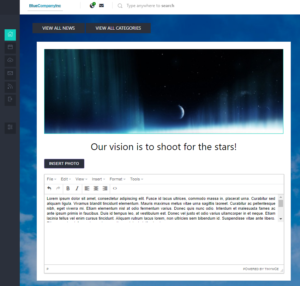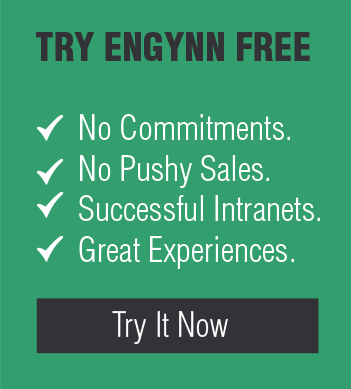Not all intranets are created equal – nor are all implementation plans. Best practice on intranet sites matter.
I’ve been part of organizations where the intranet ends up being left on the back burner when things get busy, and best practices get thrown out the window. This can be a tragic hit to all the hard work you’ve put into planning and rolling out an intranet. Over time, I’ve found there are several best practices that you can follow to ensure you reap the full benefits of a highly engaging, social intranet software that helps achieve stronger engagement in your organization.
Here’s my top four, never forgotten, best practices:
1) Stick to a schedule with your communications!
Want to know the first change you can make to instantly improve organizational engagement?
Communicate more consistently! I always encourage businesses to fully take advantage of the communications tools available in our intranet, such as news articles or status updates. Communicating with employees makes them feel involved, included in the vision, and gives them the necessary information to move forward.

Engynn Intranet Article Writer
However! Here’s the trick :
Communication has to be consistent.
This year, Forbes wrote about the importance of consistency is the key to strong communication, and it’s true, even internally! Choose realistic days that your management/hr/communications staff will post company news, and stick to it! When users begin expecting communication, failure to deliver new communications on that schedule will cause them to be disengaged with your intranet. In fact, as an executive overseeing intranets in various organizations – I would force myself to write articles every single week, regardless of whether or not there was news! Some weeks, I would just write content about our recent google reviews. I would NEVER (in most cases) divert from schedule.
2) Make it fully part of your business processes, wherever possible!
Okay – I’m about to say something that sounds completely backwards:
some of our clients start their intranets before they even should!
If marketing or HR are the only ones ready for an intranet to be part of their business processes, then you’re likely to fail. You should follow two steps:
- Ensure every major decision maker, manager, or supervisor understands exactly what your intranet is and it’s purpose.
- Ensure the intranet integrates with all business processes, to whatever extent is possible
Here’s a great example of when this can become an issue:
One of our users who was in charge of the intranet worked in internal communications (marketing), and could not find out why new hires were not logging into their accounts very often. Well it turned out, nobody in HR had added “demonstrate intranet” to the new employee checklist. Not only does this leave new employees to find the intranet themselves, but it fails to demonstrate that the intranet is an important part of the organizations’ communication.
If you choose to implement the intranet into your business – make it part of your business 100%. Ensure all interoffice communication is done on the intranet, host all your files consistently, and make sure people know it’s there to help. We suggest writing a business initiative plan – here’s a great resource from the folks at Bizfluent.
3) Ensure everyone is on board, every day – no exceptions.
Interested in knowing how to unravel all the hard work you’ve put into your intranet? Here’s how:
have a key management person not care about it! For an intranet to be successful, EVERYONE has to care about it and understand the benefits. I’ve worked in organizations where the Chief Operational Officer had not logged in once. In fact – marketing kept all key files and resources in the intranet, but operations still used printed operational binders. This not only causes employee confusion, but distrust that the intranet is doing it’s job. For the sake of your success – ensure all key management roles are on board with the intranet, understand it, and when they don’t use it for obvious tasks: call them out!
One of my favourite articles on getting users on-board to new initiatives comes from Prosci.
4) Do a monthly review of content and users!
Here’s an obvious rule about content, files, and other materials on your intranet: it should be up to date at all times! Avoid jamming your intranet up with content that is irrelevant to users.
Here’s something I’ve seen happen too many times to count:
a company will start their intranet with excitement, and load it up with tons of amazing resources! However, as time goes by – the content gets old. In 2018, I was doing some consulting for a client and reviewed their content – they had policies from 2015, logos that have since been changed, and even user accounts for people who had been fired nearly 3.5 years earlier!
If you fail to keep content current, you’re defeating the point of even having a live intranet! Do a monthly review, and keep things as current as possible!
In Conclusion
Remember these best practices, and you’ll ensure your intranet is not just another boring portal employees don’t want to use. And if you have questions – feel free to contact our “Happy To Help” team at solutions@engynn.com

